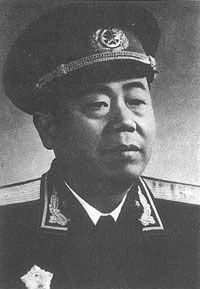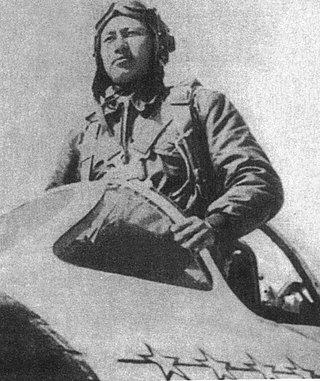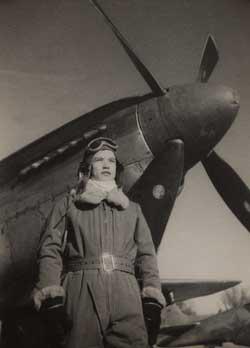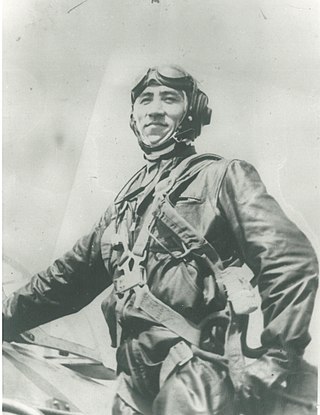
The People's Liberation Army Air Force, also referred to as the Chinese Air Force (中国空军) or the People's Air Force (人民空军), is an aerial service branch of the People's Liberation Army, the regular armed forces of the People's Republic of China. The PLAAF was officially established on 11 November 1949 and it is composed of five branches: aviation, ground-based air defense, radar, Airborne Corps and other support elements.

Anshan Teng'ao Airport, also called Anshan Air Base is a civil-military airport serving the city of Anshan in Liaoning Province, and a People's Liberation Army Air Force (PLAAF) installation in the Northern Theater Command Air Force. It is located in the town of Teng'ao, 11.8 km southwest of the city center. The airport maintains regular commercial flights to a handful of major Chinese cities, including Beijing, Shanghai, Nanjing, Chengdu, and Guangzhou. The airport also serves as the headquarters of the 1st Fighter Brigade which operates Chengdu J-20 stealth fighters. Commercial flights began in 1987, ceased in 2002, and resumed in April 2011 with a single route to Beijing.

The Guangzhou Military Region was from 1955 to 2016 one of the People's Liberation Army PLA Military Regions, located in the south of the People's Republic of China. In May 1949, the Central China Military Region (MR) was formed. In March 1955, it was divided into two, the Guangzhou MR and the Wuhan Military Region. When the Wuhan MR was disbanded in August 1985, its troops stationed around the Hubei province were assigned to the Guangzhou MR.
The 15th Fighter Aviation Division is a formation of the Chinese People's Liberation Army Air Force.
The 24th Fighter Aviation Division is a unit of the Chinese People's Liberation Army Air Force. It is headquartered at Yangcun Air Base in the Beijing Military Region. The unit is equipped with J-8 fighters. PLA-AF fighter divisions generally consist of about 17,000 personnel and 70-120 aircraft.
The 1st Fighter Brigade, sometimes called 1st Air Brigade, previously 1st Fighter Division, is a fighter aircraft unit of the Chinese People's Liberation Army Air Force (PLAAF) based at Xianyang in Shaanxi province. Part of the Northern Theater Command Air Force, the brigade was originally established as the first division level formation of the PLAAF, established 19 June 1950. In the Korean War the unit shot down 92 airplanes. It was the first in PLAAF history to fight in air combat, provide close air support, perform night bombing operations and more. It is also the only air brigade of the People's Liberation Army Air Force to participate in five Chinese national day parades. The unit's MUCD is 93056.

Nie Fengzhi was a general of the People's Liberation Army Air Force (PLAAF) of the People's Republic of China.

Zhang Jihui was the Deputy Commander of the Chinese People's Liberation Army Air Force (PLAAF) and a highly decorated fighter pilot during the Korean War. Zhang joined the PLAAF in 1945 and was one of the first combat pilots trained for the PLAAF. He was later posted at the Chinese 4th Aviation Division, which was also the first Chinese air unit that entered combat during the Korea War. On February 10, 1952, Zhang became famous in China due to the death American ace Major George Andrew Davis, Jr., and he is credited by the Chinese for shooting down the American ace. Russian sources disputed his claim 40 years later, with different theories as to who might have engaged him and how they might have done it. Zhang claimed a total of four victories during his service in Korea, and he was awarded the title Combat Hero, 1st Class during his service. After the Korean War, Zhang had held various commands and became the Deputy Commander of PLAAF in 1973. Outside of his military career, Zhang was also the Deputy Mayor of Yantai.
The 3rd Fighter Aviation Division was a formation of the Chinese People's Liberation Army Air Force (PLAAF). Initially established in 1950. PLAAF fighter divisions generally consist of about 17,000 personnel and 70-120 aircraft. The division is currently headquartered in Wuhu Air Base, Anhui.

This is the order of battle for Chinese People's Volunteer Army during major periods of hostilities in the Korean War. After the People's Republic of China entered the Korean War in October 1950 by designating the People's Liberation Army (PLA) North East Frontier Force as the People's Volunteer Army (PVA), the PVA spent the next two years and nine months in combat operations and five years and three months in garrison duties. Its last elements did not leave Korea until as late as 1958.

Zhang Tingfa was a Chinese Communist revolutionary and a major general of the People's Liberation Army Air Force (PLAAF). He served as Political Commissar and Commander of the PLAAF, and was a member of the Central Military Commission (CMC). He also served two terms as a member of the Politburo of the Chinese Communist Party, before retiring in 1985. He fought in the Second Sino-Japanese War, the Chinese Civil War, and the Korean War, and commanded the Chinese Air Force during the Sino-Vietnamese War.
The 2nd Fighter Division of the People's Liberation Army Air Force is an air formation of the People's Republic of China. It was part of the Guangzhou Military Region Air Force.
The People's Liberation Army Air Force Airborne Corps is an airborne corps under direct command of the People's Liberation Army Air Force (PLAAF). It was reorganized and renamed from the 15th Airborne Corps in May 2017 and now comprises six airborne brigades and a special operations brigade. The PLAAF Airborne Corps is China's primary strategic airborne unit and part of the newly formed rapid reaction units (RRUs) of the Chinese military which is primarily designated for airborne and special operation missions. Its role is similar to that of the U.S. Army's XVIII Airborne Corps/82nd Airborne Division/101st Airborne Division, British Army's Parachute Regiment and Russian Airborne Forces.
The 6th Fighter Division is an air division of the People's Liberation Army Air Force. It is part of the air force component of the Western Theater Command, and formerly part of the Lanzhou Military Region Air Force.
The 14 Fighter Division is a fighter aircraft unit of the Chinese People's Liberation Army Air Force (PLAAF).

Lin Hu was a Chinese aviator, fighter pilot and lieutenant general of the People's Liberation Army Air Force (PLAAF). Born to a Russian mother and a Chinese father, he was orphaned at a young age. Lin joined the Eighth Route Army to fight in the Second Sino-Japanese War before he turned 11. After the Second World War, he was trained as a fighter pilot and fought in the Korean War and the Second Taiwan Strait Crisis. He served as deputy commander of the PLA Air Force from 1985 to 1994 and attained the rank of lieutenant general in 1988.

Yao Xian was a Chinese fighter pilot and lieutenant general of the People's Liberation Army Air Force (PLAAF). He fought in the Second Sino-Japanese War and the Korean War, and later served as Deputy Commander of the Lanzhou Military Region Air Force and then concurrently as Commander of the Beijing Military Region Air Force and Deputy Commander of the Beijing MR.
The 4th Aviation Division is a formation of the Chinese People's Liberation Army Air Force (PLAAF). Initially established in 1950, it served in Korea under Commander Fang Ziyi and Commissar Ye Songsheng, flying Mikoyan-Gurevich MiG-15s. It ended its third combat tour in July 1953. It was soon redesignated the 1st Fighter Division.

The 8th Bomber Division or 8th Air Division of the People's Liberation Army Air Force (PLAAF) is an air formation of the People's Republic of China (PRC). Today, the 8th Bomber Division is assigned to the Southern Theater Command and operates Xian H-6 bombers. The 8th Bomber Division, the first and longest-serving bomber unit in the PRC, has been deployed in the 1950–1953 Korean War, 1958 Second Taiwan Strait Crisis, 1959 Tibetan uprising, and today conducts deterrence patrols in the South China Sea.









